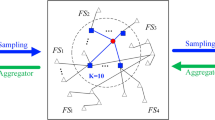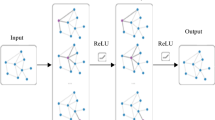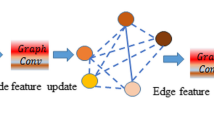Abstract
It is necessary to monitor and evaluate health state of rotating machinery, which directly affects the quality and productivity of manufacturing processes. At present, most of the existing fault diagnosis methods focus on analyzing the single sensor data. There are several problems: (1) single sensor data which only contain partial fault information are used to construct the graph, limiting the diagnosis performance; (2) the extracted traditional features containing shallow fault information have limited application scenarios. Recently, graph feature learning-based diagnosis approach shows its powerful feature learning ability, which can overcome the limitations of shallow feature extraction. In this paper, a deep graph feature learning-based diagnosis approach for rotating machinery using multi-sensor data is proposed. Singular values extracted from samples consisting of multi-sensor vibration signals are regarded as the sample node representation to construct the graph data. On the basis, a graph convolutional network is used to extract high-level features from graph data and achieve feature fusion for fault classification. Effectiveness of the proposed approach is verified on a practical experimental platform considering different working conditions (motor loads), and the results shows that it can perform well even in small training dataset.









Similar content being viewed by others
Abbreviations
- FC:
-
Fully connected layer-based feature extraction
- GCN:
-
Graph convolutional network
- Raw:
-
Raw signal-based feature extraction
- SVD:
-
Singular values decomposition
- TF:
-
Time–frequency statistics-based feature extraction
- A :
-
Adjacency matrix
- Cheb :
-
Function of Chebyshev graph convolution
- D :
-
Degree matrix
- E :
-
Edge set
- F :
-
Feature vector
- G :
-
Undirected graph
- g θ :
-
Filter of graph convolution
- H :
-
Hankel matrix
- H, I, J :
-
Scales of graph convolution layer
- h :
-
Row number of hankel matrix
- I n :
-
Identity matrix
- K :
-
Chebyshev polynomial coefficient
- L :
-
Laplacian matrix
- m :
-
Number of elements in vector
- N :
-
Number of nodes
- P :
-
Node or an object
- T :
-
Feature matrix of graph
- T k :
-
Chebyshev polynomial
- u :
-
Left singular vector
- U :
-
Eigenvector matrix
- V :
-
Node set of graph
- v :
-
Right singular vector
- W :
-
Weight matrix
- X :
-
Original signal
- X norm :
-
Normalized signal
- X filter :
-
Output of filter
- X GCN :
-
Output of Chebyshev graph convolution layer
- Z :
-
Label of samples
- σ :
-
Singular value
- θ k :
-
Chebyshev coefficient
- Λ :
-
Eigenvalue matrix of Laplacian matrix
- \({\boldsymbol{\tilde{\Lambda}}}\) :
-
Normalized version of Λ
- λ :
-
Eigenvalue
- λ max :
-
Largest element of Λ
References
Bengio, Y., Courville, A., & Vincent, P. (2013). Representation learning: A review and new perspectives. IEEE Transactions on Pattern Analysis and Machine Intelligence, 35(8), 1798–1828.
Bruna, J., Zaremba, W., Szlam, A., & LeCun, Y. (2013). Spectral networks and locally connected networks on graphs. arXiv:1312.6203.
Chen, Z., Mauricio, A., Li, W., & Gryllias, K. (2020). A deep learning method for bearing fault diagnosis based on cyclic spectral coherence and convolutional neural networks. Mechanical Systems and Signal Processing, 140, Art no. 106683. https://doi.org/10.1016/j.ymssp.2020.106683.
Dong, H., Chen, F., Wang, Z., Jia, L., Qin, Y., & Man, J. (2020). An adaptive multi-sensor fault diagnosis method for high-speed train traction converters. IEEE Transactions on Power Electronics, 36(6), 6288–6302.
Fang, Y., & Zhang, T. (2018). Vibroacoustic characterization of a permanent magnet synchronous motor powertrain for electric vehicles. IEEE Transactions on Energy Conversion, 33(1), 272–280.
Gao, Y., & Yu, D. (2020). Total variation on horizontal visibility graph and its application to rolling bearing fault diagnosis. Mechanism and Machine Theory, 147, 103768. https://doi.org/10.1016/j.mechmachtheory.2019.103768
Goyal, D., & Pabla, B. S. (2016). The vibration monitoring methods and signal processing techniques for structural health monitoring: A review. Archives of Computational Methods in Engineering, 23(4), 585–594.
Jiang, H., Chen, J., Dong, G., Liu, T., & Chen, G. (2015). Study on Hankel matrix-based SVD and its application in rolling element bearing fault diagnosis. Mechanical Systems and Signal Processing, 52–53, 338–359.
Li, X., Li, X., & Ma, H. (2020). Deep representation clustering-based fault diagnosis method with unsupervised data applied to rotating machinery. Mechanical Systems and Signal Processing, 143, Art no. 106825, https://doi.org/10.1016/j.ymssp.2020.106825.
Li, T., Zhao, Z., Sun, C., Yan, R., & Chen, X. (2021). Multireceptive field graph convolutional networks for machine fault diagnosis. IEEE Transactions on Industrial Electronics, 68(21), 12739–12749.
Lin, W., Chen, C., Tseng, Y., Tsai, Y., Chang, C., Wang, H., & Chen, C. (2018). Predicting post-stroke activities of daily living through a machine learning-based approach on initiating rehabilitation. International Journal of Medical Informatics, 111, 159–164.
Liu, J., Hu, Y., Wu, B., Fan, J., & Hu, Z. (2018a). An integrated multi-sensor fusion-based deep feature learning approach for rotating machinery diagnosis. Measurement Science and Technology, 29(5), 055103.
Liu, J., Zhou, K., Yang, C., & Lu, G. (2021). Imbalanced fault diagnosis of rotating machinery using autoencoder-based SuperGraph feature learning. Frontiers of Mechanical Engineering. https://doi.org/10.1007/s11465-021-0652-4
Liu, R., Yang, B., Zio, E., & Chen, X. (2018b). Artificial intelligence for fault diagnosis of rotating machinery: A review. Mechanical Systems and Signal Processing, 108, 33–47.
Muruganatham, B., Sanjith, M., Krishnakumar, B., & Murty, S. (2013). Roller element bearing fault diagnosis using singular spectrum analysis. Mechanical Systems and Signal Processing, 35(1–2), 150–166.
Ortega, A., Frossard, P., Kovačević, J., Moura, J. M. F., & Vandergheynst, P. (2018). Graph signal processing: Overview, challenges, and applications. Proceedings of the IEEE, 106(5), 808–828.
Pu, W., Liu, Y., Yan, J., Liu, H., & Luo, Z. (2018). Optimal estimation of sensor biases for asynchronous multi-sensor data fusion. Mathematical Programming, 170(1), 357–386.
Scarselli, F., Gori, M., & Tsoi, A. C. (2009). The graph neural network model. IEEE Transaction on Neural Networks, 20(1), 61–80.
Shuman, D. I., Narang, S. K., Frossard, P., Ortega, A., & Vandergheynst, P. (2013). The emerging field of signal processing on graphs: Extending high-dimensional data analysis to networks and other irregular domains. IEEE Signal Processing Magazine, 30(3), 83–98.
Song, T., Zheng, W., Song, P., & Cui, Z. (2020). EEG emotion recognition using dynamical graph convolutional neural networks. IEEE Transactions on Affective Computing, 11(3), 532–541.
Wang, H., Zhao, M., Xie, X., Li, W., & Guo, M. (2019). Knowledge graph convolutional networks for recommender systems. In Proceedings of the 2019 world wide web conference. arXiv:1904.12575v1.
Wang, T., Liu, Z., Lu, G., & Liu, J. (2021a). Temporal-spatio graph based spectrum analysis for bearing fault detection and diagnosis. IEEE Transactions on Industrial Electronics, 68(3), 2598–2607.
Wang, Y., Gao, L., Gao, Y., & Li, X. (2021b). A new graph-based semi-supervised method for surface defect classification. Robotics and Computer-Integrated Manufacturing, 68, Art no. 102083. https://doi.org/10.1016/j.rcim.2020.102083.
Wen, X., Lu. G., Liu, J., & Yan, P. (2020). Graph modeling of singular values for early fault detection and diagnosis of rolling element bearings. Mechanical Systems and Signal Processing, 145, Art no. 106956. https://doi.org/10.1016/j.ymssp.2020.106956.
Xue, Y., Li, Z., Wang, B., Zhao, Z., & Li, F. (2018). Nonlinear feature selection using Gaussian kernel SVM-RFE for fault diagnosis. Applied Intelligence, 48(10), 3306–3331.
Yang, C., Zhou, K., & Liu, J. (2022). SuperGraph: Spatial-temporal graph-based feature extraction for rotating machinery diagnosis. IEEE Transactions on Industrial Electronics, 69(4), 4167–4176. https://doi.org/10.1109/TIE.2021.3075871
Zhang, D., Stewart, E., Entezami, M., Roberts, C., & Yu, D. (2020). Intelligent acoustic-based fault diagnosis of roller bearings using a deep graph convolutional network. Measurement, 156, Art no. 107585. https://doi.org/10.1016/j.measurement.2020.107585.
Zhang, X., Liang, Y., Zhou, J., & Zang, Y. (2015). A novel bearing fault diagnosis model integrated permutation entropy, ensemble empirical mode decomposition and optimized SVM. Measurement, 69, 164–179.
Zhao, M., & Jia, X. (2017). A novel strategy for signal denoising using reweighted svd and its applications to weak fault feature enhancement of rotating machinery. Mechanical Systems and Signal Processing, 94(15), 129–147.
Zhao, R., Yan, R., Chen, Z., Mao, K., Wang, P., & Gao, R. X. (2019). Deep learning and its applications to machine health monitoring. Mechanical Systems and Signal Processing, 115(15), 213–237.
Zhao, X., & Ye, B. (2009). Similarity of signal processing effect between Hankel matrix-based SVD and wavelet transform and its mechanism analysis. Mechanical Systems and Signal Processing, 23(4), 1062–1075.
Zhao, X., & Ye, B. (2011). Selection of effective singular values using difference spectrum and its application to fault diagnosis of headstock. Mechanical Systems and Signal Processing, 25(5), 1617–1631.
Acknowledgements
This work was supported in part by the National Key Research and Development Program of China under Grant 2020YFB1711201.
Funding
Jie Liu National Key Research and Development Program of China, 2020YFB1711201.
Author information
Authors and Affiliations
Corresponding author
Additional information
Publisher's Note
Springer Nature remains neutral with regard to jurisdictional claims in published maps and institutional affiliations.
Rights and permissions
About this article
Cite this article
Zhou, K., Yang, C., Liu, J. et al. Deep graph feature learning-based diagnosis approach for rotating machinery using multi-sensor data. J Intell Manuf 34, 1965–1974 (2023). https://doi.org/10.1007/s10845-021-01884-y
Received:
Accepted:
Published:
Issue Date:
DOI: https://doi.org/10.1007/s10845-021-01884-y




